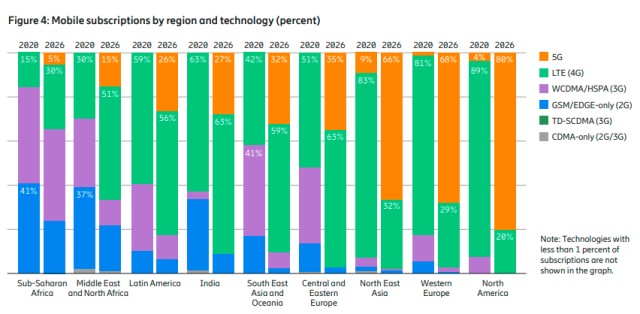AT&T, T-Mobile US and Verizon have struggled to win customers for their 5G business despite spending billions towards Capex in the United States.
 AT&T, T-Mobile and Verizon will reveal their Capex plans for the first quarter and the full year targeting additional growth in 5G coverage.
AT&T, T-Mobile and Verizon will reveal their Capex plans for the first quarter and the full year targeting additional growth in 5G coverage.
Ericsson earlier noted that 5G commercialization is moving at a rapid pace in North America. Providers have already launched commercial 5G services, focused on mobile broadband. The introduction of 5G smartphones supporting all three spectrum bands will make 2021 an eventful year for early 5G adopters.
FWA will play a key role in closing the digital divide where the pandemic has exposed large gaps for education, remote working and small businesses. By 2026, more than 340 million 5G subscriptions are anticipated in the North America region, accounting for 80 percent of mobile subscriptions, Ericsson said in its mobility report for November 2020.
Telecom industry body 5G Americas earlier said North America had 3.4 million 5G connections and over half a billion LTE connections, by the end of Q3 2020. Telecoms in North America added over 1 million 5G connections in Q3 over the quarter.
AT&T, T-Mobile and Verizon have not yet revealed the number of 5G subscribers. Their current focus is on the expansion of 5G network coverage.
Operators need to position their pricing and value propositions to attract the next wave of consumer and enterprise users, says Strategy Analytics report.
“As more affordable 5G phones come to market, they need to be paired with options for both high value premium plans with more HD content and entry level plans for users who buy a 5G device just because it has a good promotion or camera or brand they want,” Guang Yang, director, Strategy Analytics Service Provider Strategies, said.
Verizon
Verizon’s first announcement in 2021 was on the expansion of 5G Home Internet. Verizon will expand the super fast home internet service to more locations. Verizon has also revealed the name of the new locations.
“We ended 2020 with 2,700 cities with Nationwide 5G service serving 230 million people, 61 cities with Ultra Wideband service, and 12 cities with access to our 5G Home service; and we’re not slowing down,” said Kyle Malady, chief technology officer for Verizon.
Verizon’s 5G Home Internet offers max download speeds of up to 1 Gbps, depending on location, with typical download speeds of 300 Mbps.
Customers can visit https://www.verizon.com/5g/home to find out if 5G Home Internet is in your area.
Verizon’s 5G Ultra Wideband offers ultra-fast wireless speeds, up to 4 Gbps in some places.
5G Mobility customers will be received 5G Ultra Wideband speeds using one of 28 5G Ultra Wideband capable devices while in a 5G Ultra Wideband coverage area. Customers also have access to Verizon’s 5G Nationwide service for no additional cost with Unlimited Plans.
https://www.verizon.com/coverage-map/ enables customers to understand specific 5G coverage of Verizon.
“We create the networks that move the world forward, and our 5G network brings incredible capabilities that will drive us all as we move into the new year,” said Ronan Dunne, CEO of Verizon Consumer Group. “We’re committed to providing our customers with access to the newest technologies and experiences that will shape our future.”
T-Mobile
T-Mobile recently said its 5G covers 280 million people across nearly 1.6 million square miles, nearly 4x more than Verizon and over 2.5x more than AT&T.
Ultra Capacity 5G covers 106 million people, over 50x more than Verizon’s 5G Ultra Wideband, with nationwide coverage expected by the end of 2021.
T-Mobile expanded its 5G network leadership, now reaching 280 million people and covering 106 million people with Ultra Capacity 5G’s super-fast speeds enabled by mid-band (2.5 GHz) and millimeter wave spectrum.
T-Mobile said the 106 million surpassed the company’s goal to cover 100 million Americans in 2020 and compared to an estimated 2 million people covered by Verizon’s Ultra Wideband 5G, showcasing T-Mobile’s lead in the 5G race.
“T-Mobile’s high speed Ultra Capacity 5G covers over 50 times more people than Verizon. We are way ahead of the competition on 5G and poised to become the country’s overall network leader,” said Mike Sievert, T-Mobile CEO.
AT&T
AT&T will provide its 2021 financial outlook and capital allocation guidance when it reports fourth-quarter and full-year 2020 results on Wednesday, January 27, 2021.
Strategy Analytics said in its latest report said network deployments must cater to the diverse needs of enterprise and consumer segments to maximize service adoption and revenue generation. Operators must build 5G networks with a clear mapping of traffic profiles against specific locations.
Low-band spectrum is critical for coverage and some early launches and mid-band crucial for a differentiated high-bandwidth network experience, the combination allowing operators to maximize early use case opportunities across valuable customer segments.
5G pricing must contain ‘More for More’ elements to offer B2C ARPU uplift potential and factor in 5G service performance characteristics, such as low latency, for B2B relevance.
“Rapid social and business change happening in 2020 as a result of Covid-19 has emphasized the value of high quality network experiences and the need for businesses to adopt new operational models. In these scenarios, flexibility is arguably the killer app for 5G,” Phil Kendall, executive director, Strategy Analytics Service Provider Group, said.
Baburajan K





